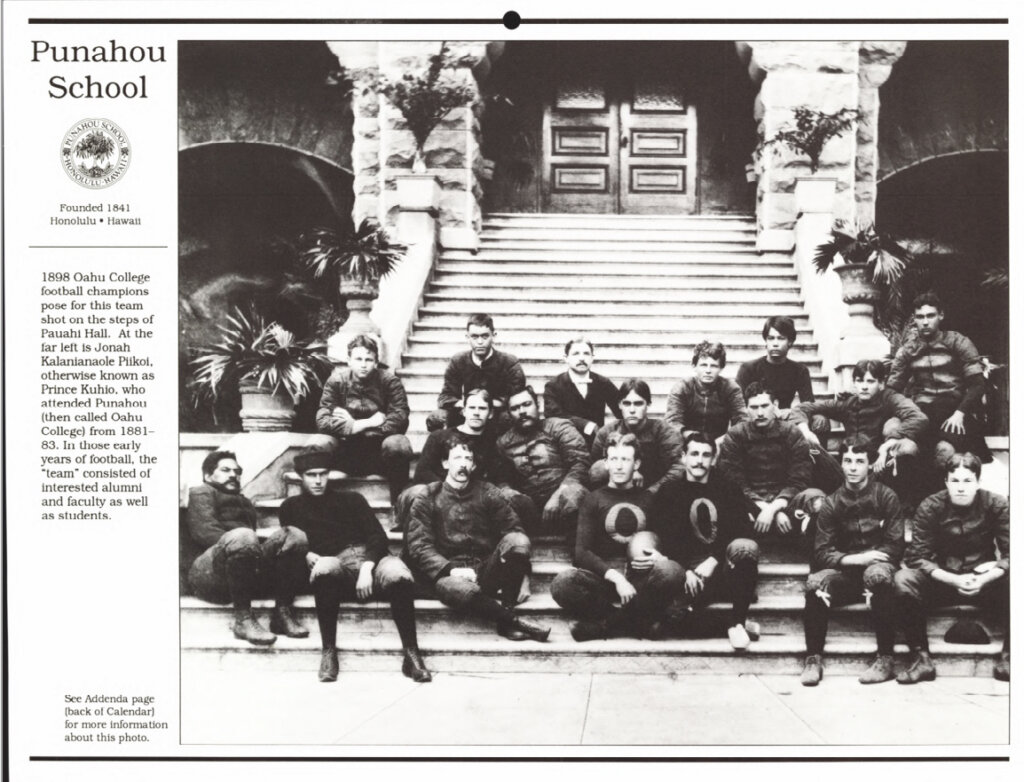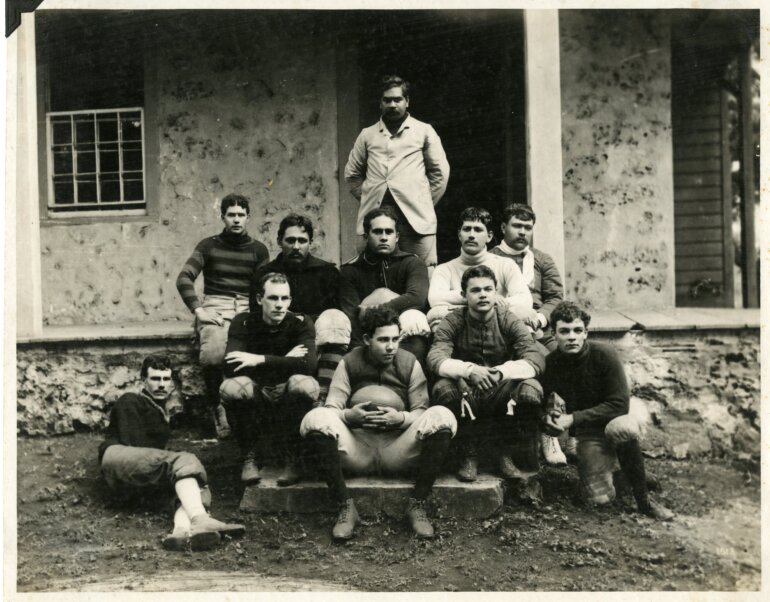In honor of Hawai‘i’s annual holiday, Prince Kūhiō Day, we’re taking a look back through Punahou’s Archives. The day celebrates the birth of Prince Jonah Kūhiō Kalaniana‘ole Pi’ikoi (c. 1888) on March 26, 1871, Punahou’s first alumnus to represent Hawai’i in the U.S. Congress from 1902 – 1922.
Kūhiō attended Punahou for two years during middle school and is considered a Punahou alumnus from what would have been his graduating class around 1888. The youthful Kūhiō was a sports enthusiast, including participating in the burgeoning sport of football, as documented in the historic photo, shown above, from 1900.
Beginning his education at St. Alban’s (now ‘Iolani School) in the 1870s, he attended Punahou School from 1881 – 1883. His older brothers, Edward Keli’iahonui and David Kawānanakoa, also attended Punahou. In 1885, he was sent with his brothers to attend San Matthew’s Military School in San Mateo. The brothers taught “board surfing” to California locals for the first time in 1885 in Santa Cruz.
During Kūhiō’s school days, football was in its infancy in the U.S., often a mashup of rugby and soccer. The earliest game in Hawai‘i, played with rugby rules, was reportedly by Oahu College boys in 1877. The first high school football team was formed in 1890 by Punahou teacher, J.D. Wood, and included students and faculty. Wood also organized a faculty team at Kamehameha School. The only other teams were military squads or teams fielded among adults in the community. In 1903, Kamehameha and Honolulu High School (McKinley) began regular games with Punahou, frequently including graduates, such as Kūhiō, on the early teams. In 1909, football began at the University of Hawai‘i and the ILH was organized to clarify student eligibility.
In the photo, at top, from the Punahou Archive taken on Jan. 1, 1900, the “Town” team defeated the 6th Artillery military team by a score of 81-0 in a game played on the Punahou field, with Kūhiō at right half. Part of Old School Hall had become the School’s first locker room which may account for the location of the photo. Apparently during the game, Kūhiō and Sam Parker Jr. (1900) decided to sit out, and the Town team went on to win with only nine players.
In addition to Kūhiō (standing at rear), the photo includes: back row, left to right: Vivian Richardson, Charles Notley, Sam Parker Jr. (1900), John C. Lane and John H. Wise; bottom row, left to right: Antone Lawrence (reclining), James Greenwell, William McLean, Patrick Gleason and Bill Vida (1894).
A note on the photo reads: “Cupid at top.” Prince Cupid was a nickname was reportedly coined by a French teacher at St. Alban’s referencing Prince Kūhiō’s cherubic demeanor, but may have later in life evoked his romantic spirit. This game in 1900 must have been a welcome respite from the serious political business of the day.
Kūhiō had participated in the 1895 rebellion to restore his aunt Queen Lili’uokalani to the throne, for which he spent a year in prison. By 1902 Prince Kūhiō was elected as a Republican delegate to the U.S. Congress, where he served until his death in 1922, winning 10 elections. Among his many actions as a statesman, he instituted local county government; reorganized the Royal Order of Kamehameha I which held the first Kamehameha Day in 1904; introduced the first Hawaii Statehood Act in 1919; brought forward two bills requesting the territorial right to grant women’s suffrage; and served on the first Hawaiian Homes Commission.


